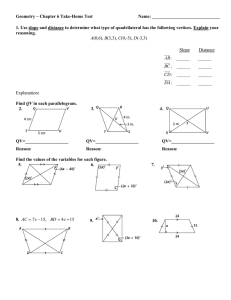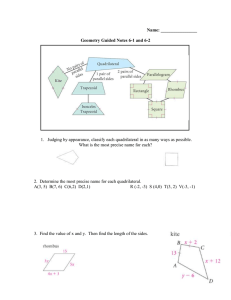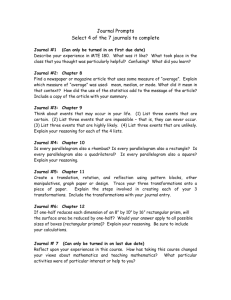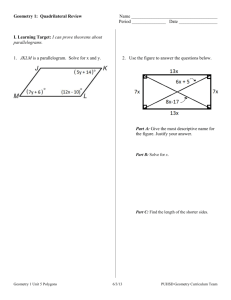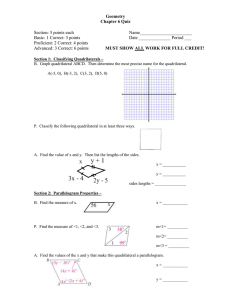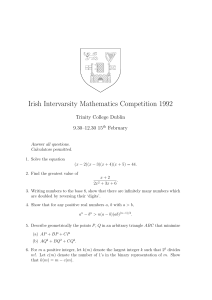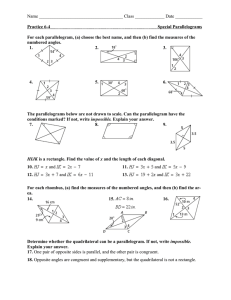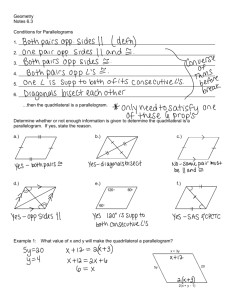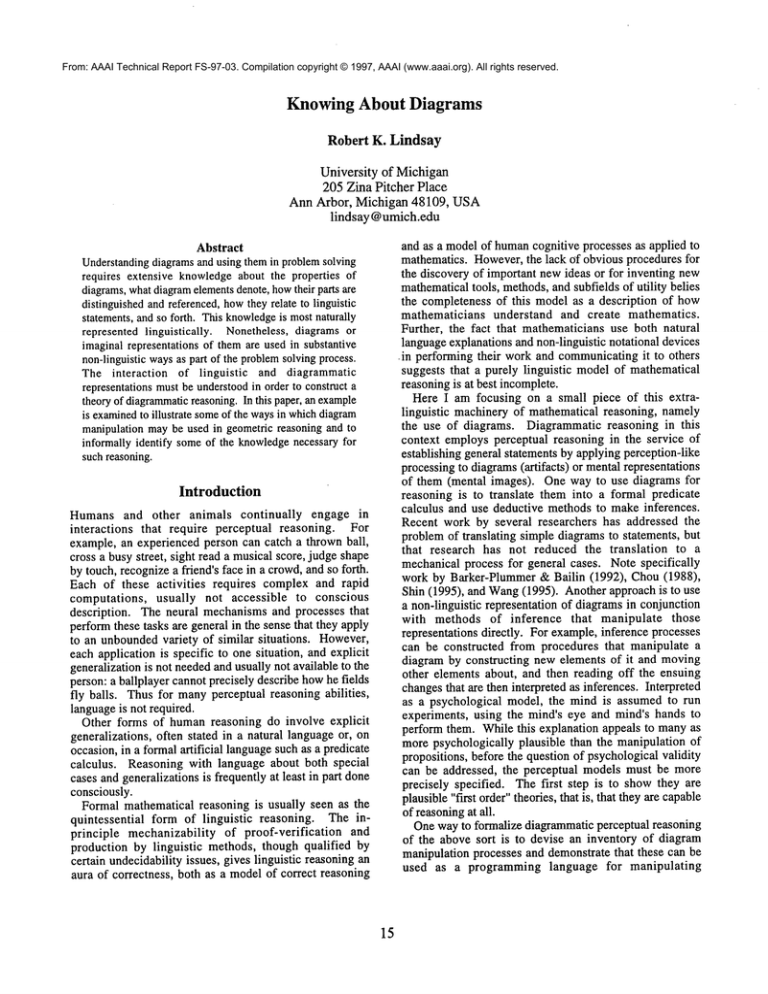
From: AAAI Technical Report FS-97-03. Compilation copyright © 1997, AAAI (www.aaai.org). All rights reserved.
Knowing About Diagrams
Robert K. Lindsay
University of Michigan
205 Zina Pitcher Place
Ann Arbor, Michigan 48109, USA
lindsay @umich.edu
and as a modelof humancognitive processes as applied to
mathematics. However,the lack of obvious procedures for
the discovery of important new ideas or for inventing new
mathematicaltools, methods,and subfields of utility belies
the completeness of this model as a description of how
mathematicians understand and create mathematics.
Further, the fact that mathematicians use both natural
languageexplanations and non-linguistic notational devices
-in performing their work and communicatingit to others
suggests that a purely linguistic model of mathematical
reasoningis at best incomplete.
Here I am focusing on a small piece of this extralinguistic machinery of mathematical reasoning, namely
the use of diagrams. Diagrammatic reasoning in this
context employs perceptual reasoning in the service of
establishing general statements by applying perception-like
processingto diagrams(artifacts) or mental representations
of them (mental images). One way to use diagrams for
reasoning is to translate them into a formal predicate
calculus and use deductive methods to make inferences.
Recent work by several researchers has addressed the
problem of translating simple diagrams to statements, but
that research has not reduced the translation to a
mechanical process for general cases. Note specifically
work by Barker-Plummer & Bailin (1992), Chou (1988),
Shin (1995), and Wang(1995). Another approach is to
a non-linguistic representation of diagrams in conjunction
with methods of inference that manipulate those
representations directly. For example, inference processes
can be constructed from procedures that manipulate a
diagram by constructing new elements of it and moving
other elements about, and then reading off the ensuing
changesthat are then interpreted as inferences. Interpreted
as a psychological model, the mind is assumed to run
experiments, using the mind’s eye and mind’s hands to
perform them. While this explanation appeals to manyas
more psychologically plausible than the manipulation of
propositions, before the question of psychological validity
can be addressed, the perceptual models must be more
precisely specified. The first step is to show they are
plausible "first order" theories, that is, that they are capable
of reasoningat all.
One way to formalize diagrammatic perceptual reasoning
of the above sort is to devise an inventory of diagram
manipulation processes and demonstrate that these can be
used as a programming language for manipulating
Abstract
Understandingdiagramsand using themin problemsolving
requires extensive knowledgeabout the properties of
diagrams,whatdiagramelementsdenote,howtheir parts are
distinguishedandreferenced, howthey relate to linguistic
statements,and so forth. This knowledge
is mostnaturally
represented linguistically. Nonetheless, diagrams or
imaginalrepresentations of themare used in substantive
non-linguisticwaysas part of the problemsolving process.
The interaction of linguistic
and diagrammatic
representationsmustbe understoodin order to construct a
theory of diagrammatic
reasoning.In this paper, an example
is examined
to illustrate someof the waysin whichdiagram
manipulationmaybe used in geometric reasoning and to
informally identify someof the knowledgenecessary for
suchreasoning.
Introduction
Humans and other animals continually
engage in
interactions that require perceptual reasoning. For
example, an experienced person can catch a thrown ball,
cross a busy street, sight read a musical score, judge shape
by touch, recognizea friend’s face in a crowd,and so forth.
Each of these activities requires complex and rapid
computations, usually not accessible to conscious
description. The neural mechanisms and processes that
performthese tasks are general in the sense that they apply
to an unboundedvariety of similar situations. However,
each application is specific to one situation, and explicit
generalization is not neededand usually not available to the
person: a ballplayer cannot precisely describe howhe fields
fly balls. Thus for manyperceptual reasoning abilities,
languageis not required.
Other forms of humanreasoning do involve explicit
generalizations, often stated in a natural language or, on
occasion, in a formal artificial languagesuch as a predicate
calculus. Reasoning with language about both special
cases and generalizations is frequently at least in part done
consciously.
Formal mathematical reasoning is usually seen as the
quintessential
form of linguistic reasoning. The inprinciple mechanizability of proof-verification
and
production by linguistic methods, though qualified by
certain undecidability issues, gives linguistic reasoning an
aura of correctness, both as a modelof correct reasoning
15
diagrams in productive ways. For example, Furnas (1992)
has devised the "bitpict"
system that allows the
specification of processes that transformsmall pixel arrays
into other pixel arrays, and has demonstrated how some
"programs"composedof such operations can be written to
solve problems. Anderson & McCartney (1995, 1996)
define a system of picture element manipulation processes
that can be combined according to explicit rules into
programs that solve problems strictly by manipulating
pixel-arrays. Mywork is similar to those approaches in
that it also performs computations on pixel arrays.
However,the picture manipulation processes are described
at a higher level of aggregation, namelyat the level of the
manipulations of geometric objects, such as "construct a
line between two points" and "determine if two lines are
parallel." These processes are then available to write
programs that create and manipulate diagrams. One class
of such programs can follow diagram manipulation steps
that demonstrate certain geometric propositions and verify
that the results support the conclusion (Lindsay, in press).
In the present paper I am concerned with how such
processes can be employedstrategically to devise programs
appropriate to a given reasoningtask.
I have emphasizedelsewhere - Lindsay (1996) - that
account of conscious geometric reasoning with diagrams
must employ propositional
as well as pictorial
representations and manipulations. This would be true if
only because the mathematical statements proved,
demonstrated, or understood are propositional in form,
usually universally quantified assertions (e.g., "The sumof
the interior angles of any plane triangle is equal in measure
to a straight angle"), and some connection must be
established between the reasoning and the conclusion.
Morefundamentally, the very strategy of using diagrams in
a substantive way requires the constant interaction of
diagram elements and propositions, notably in the form of
constraints imposed on the diagram ("This angle is
always - to remain a right angle no matter what other
changes are made"). Indeed it is undeniable that mental
experiments can be run according to a variety of
assumptions,for examplethat the objects are rigid, or that
they are plastic. That is, diagrammatic reasoning is
"cognitively penetrable" (Pylyshyn, 1984), where what
"cognitive" is described propositionally.
However, propositional knowledge is used in many
essential ways other than to state a conclusion and the
premises underlying it. This essential knowledgeincludes
generalizations about invariants, inventories of special
cases, definitions of symmetry, knowledgeof algebraic
relations, generalizations of prior conclusions, and
knowledgeof problemsolving strategies and heuristics. It
is desirable to establish an inventory of the knowledgethat,
in addition to the knowledge of space built into the
programminglanguage, is needed to devise methods that
can achieve human-like reasoning about geometry. Once
this is done, that knowledgemust be represented in ways
that can interact with diagrammaticrepresentations and be
used to verify demonstrations, create demonstrations, and
ultimately perhaps to discover geometric propositions that
were not explicitly conveyedto the program.
I will illustrate
by example how a "programming
language" must be augmentedto support the invention of
demonstrations and the discovery of geometric relations. I
will use one exampleto illustrate a range of diagrammatic
reasoning strategies and the knowledgeunderlying them.
The Example
The example concerns the Quadrilateral Theorem (QT),
informally:
"The figure formed by connecting the
midpoints of the sides of any quadrilateral
is a
parallelogram." This theorem, pe/’haps initially surprising,
is true for convexas well as concavequadrilaterals.
Understanding by Proof
One way to understand this theorem is to understand its
fully formal proof, by following the proof and checking its
steps for validity one-by-one. Diagramsare not part of a
fully formal proof. For most of us, a better way to
understand this theoremis a "textbook proof." By textbook
proof I meanthe sort of quasi-formal argumentfavored in
textbooks and classroom teaching. They are almost
invariably accompaniedby a diagram whose connection to
the propositional argumentis not formalized. Typically the
diagram accompanyinga textbook proof illustrates only
one specific instance of the general proposition. Textbook
proofs usually omit proving manyproperties that are true
of the diagram; the bulk of a fully formal proof typically
addresses these omissions from the textbook proof. Thus
textbookproofs are not rigorous.
Understandinga textbook proof requires the ability to
understand both natural language and diagrams. It also
requires seeing howthe conclusion of the theoremis based
upon other theorems and lemmas that are previously
understood, and so on back to the axiomsof geometrythat
presumably are accepted as obvious, whatever might cause
that. Devising a proof is a more difficult task than
understanding one, and reflects an understanding of the
theoremin an even deeper sense.
Reasoning by Diagram Manipulation
The following discussion illustrates a variety of waysthat
diagram observation and manipulation can be used to
support reasoning. It will be understandable because the
reader understands a numberof unstated assumptions that
need to be captured if a programis to be able to follow or
generate such arguments.
The QTapplies to "any" quadrilateral; it is a universal
statement. The starting point for using a diagramtypically
is to choose one particular illustration of the concept or
proposition in question. For the QTthis means selecting
four points on a sheet of paper and connecting them to
form a quadrilateral, or doing something of that sort
mentally. However, a single diagram is notoriously
deficient in its ability to represent universal propositions.
16
One commonway around this deficiency is to choose a
particular case that has no special properties that maybe
responsible for the generalization. That is, one wants a
representative instance. Care is taken so that the figure so
selected is not one of a numberof "special" quadrilaterals,
those that have other properties, such as rhombuses or
trapezoids. However, this presupposes knowledge about
what properties are special in this sense. For the QT, each
side and each angle of the chosenquadrilateral should be of
different measure, and special angle measures, such as 0,
45, and 90 degrees, should also be avoided. No pairs of
sides should be equal, parallel, or perpendicular.
Drawor imagine a representative quadrilateral, find the
midpoints of its sides and connect them palrwise. Finally,
examine the inscribed figure and note that it is a
parallelogram. Since the original quadrilateral was chosen
"arbitrarily" and had no properties knownby previous
experience to yield additional special features, one is
encouragedto accept the generality of the proposition. As
a further check one could try other quadrilaterals as starting
points to further reduce the probability of having hit upona
special case. One could also attempt to construct a
counterexample, since a single counterexamplesuffices to
disprove a conjecture.
Furthermore, there is a "syntactic" symmetry to the
situation (Gelernter, 1959, Lindsay, 1996) in the sense
that, since the figure is arbitrary to begin with, if one could
show that the movementof any one vertex preserved the
property, one could show it true for the movementof any
other vertex by a similar procedure. So we are encouraged
to believe that no counterexample exists if we have one
valid instance and can showthat moving a single vertex
preserves the midpoint-parallelogramproperty.
Note further that an arbitrary target movementof a
vertex can be broken into any number of steps whose
vector sumis the target movement.In particular, the target
movementcan be broken into just two steps in distinct
directions that need not be orthogonal. This presumespath
independence, that the relevant properties of a geometric
figure are determined by its static configuration,
independently of how it was constructed. This is a
property of geometricfigures, but not in general of physical
situations involving energy transformations. If each of
these sub-movementsis property preserving, the total
movementmust be.
The next step might be to select two distinct directions
such that movements
in those directions can be easily seen
to preserve the parallelogram-property. The vertical and
horizontal directions of the paper are not a priori
interesting
choices since geometry is orientation
independent;the only relevant directions are those relative
to objects in the figure. Theseinclude the directions of the
quadrilateral sides and the sides of the parallelogram.
Closer observation showsthat the parallelogram sides are
also the directions of the (unconstructed) diagonals of the
quadrilateral. That observation, triggered by the search for
significant directions, maybe valuable (in particular, it
helps to understandthe textbookproof given later).
What happens if vertex C of Figure 1 is movedin the
direction of the orientation of segment PQ(from P toward
Q), directly away from its opposite vertex A? What
happensif vertex C of Figure 1 is movedin the direction of
segment QR? We could actually make these movements
and observe that the parallelogram-property is preserved,
but can we show in a deeper sense why it must be
preserved?
Let’s examine more closely the relation between
quadrilaterals and inscribed parallelograms. Clearly it is
possible to inscribe non-parallelograms by choosing
appropriatepoints on the quadrilateral’s sides. Is it possible
to inscribe a parallelogram within a quadrilateral without
connecting midpoints? If we connect two non-midpoints P
and Q with a line (See Figure 2) and attempt to construct
parallelogram with that as one side, the length and
orientation
of the opposite side of the inscribed
parallelogram are determined. Wecan make a copy, P’Q’,
of the first line PQand moveit parallel to itself until it
contacts one of the other two quadrilateral sides, hold that
end on the contacted side, maintaining orientation and
length, and slide P’Q’ along the contacted side until it
contacts the fourth side with P’ at S and Q’ at R.
Completing the figure yields a parallelogram PQRSthat
Deeper Understanding
Although the observation of several appropriate special
cases is compelling, there is a deeper and more important
sense of understanding that is aided by diagrams. One
wouldlike to know"why"the theoremis true.
One could modifythe original quadrilateral by dragging
one vertex and noting that the constructed figure remains a
parallelogram. This not only provides a sequence of
several examples, but shows how altering one property
alters others in an exactly compensatoryway.
Giventhat one has a specific instance of the appropriate
diagram, say Figure 1, one could ask if an arbitrary change
will preserve the parallelogram property. A given
quadrilateral
can be transformed into any other
quadrilateral by movingits vertices to the location of the
new quadrilateral vertices. The order of making these
alterations is immaterial;only the end result matters.
D
S
R
A
C
Figure 1
17
does not connect the quadrilateral’s midpoints. Thus the
midpoints do not define the only inscribed parallelogram.
R and S are uniquely determined once P and Q are chosen
becausethere is at most one "slice" of the other half of the
quadrilateral of that length and orientation because the
sides converge to D. This is observed by diagram
manipulation combinedwith an analysis of the available
degrees of freedom. However,if PQis too long (say UV)
there maybe no solutions, since there is no possible "slice"
at that orientation.
S
A
pP’
c
B
Figure 2
If we had picked P and Q as midpoints, would this
procedure force R and S to be midpoints? Experiment
seemsto confirmthis but does not establish it in general.
Here is another approach. Starting with an arbitrary
parallelogram, let us circumscribe a quadrilateral whose
sides are tangent to the parallelogram’s vertices. Do the
vertices of the parallelogrambisect the quadrilateral sides?
This proves not to be true; an indefinite number of
quadrilaterals can circumscribe a given parallelogram.
/
/
line 1
two circumscribing
lines (1 and 2) are uniquely
determined. This is because two points uniquely determine
a line. However,one quadrilateral vertex on each of line 1
and line 2 may be freely chosen anywhere on the line
subject to the constraint that they lie on the sameside of the
extended opposite parallelogram side QRas does A.
Choice of these two points B and D determines 3 of the
vertices of the quadrilateral. But placing B and D also
determines the directions
of the remaining two
quadrilateral sides since they must pass through Q and R,
respectively. Their intersection, the fourth vertex C, is thus
also determined. Since points B and D may be altered
subject only to the constraint above, we again see that the
midpoint property is not necessary. Whatif we force it to
hold by choosing B and D accordingly, as in Figure 3?
Thenit will be observedthat the quadrilateral is uniquely
determined,and it satisfies the midpointproperty. It is thus
possible to construct a circumscribingquadrilateral obeying
the parallelogram-property
around an arbitrary
parallelogram. Wehave also learned that the situation has
only a few degrees of freedom: selecting one quadrilateral
vertex fixes the midpoint quadrilateral for a given
parallelogram.
The foregoing experiments have not led to a complete
understanding of why the QT should hold, but have
provided information about the quadrilateral-parallelogram
relationship.
Another useful strategy is to start with the simplest
special case, and verify the proposition for it. This is often
relatively
easy because special properties enforce
symmetries; that’s what makes them special. Wemay then
be able to showthat departures from the special case do not
alter the proposition. Here we would start with the
simplest, most symmetric quadrilateral, a square. Wesee
that the inscribed midpointpolygonis also a square. In the
previous case, difficult measurements were needed to
verify a potential relation. However,in this symmetric
case the measurements are simple because they follow
from the observation of bilateral symmetry, something
humanperception is goodat.
C
/
/
7" ---
\
D
--
C
A
Q
--]
B
Figure 4
line 2
Nowwhat would happen if we make the square into a
rectangle by lengthening a pair of opposite sides equally?
See Figure 4. It is readily seen that the inscribed square’s
vertices that lie on the elongated lines (ABand DC)move
in the same direction and by the same amount, half of the
Figure 3
Next consider Figure 3. Starting with a parallelogram
PQRS
and an arbitrary point A outside it, the directions of
18
elongation. The sides of the inscribed figure change
orientation,
but our bilateral
symmetry detectors
immediately see that opposite pairs change by the same
amounts and the figure remains symmetric. Wenow have
a parallelogram inscribed in a rectangle - the condition
remains true. Again, syntactic symmetrydetection shows
us that the samewill happenif we nowstretch or shrink the
rectangle in its other dimension.
D
A
R
R’
P
and B, in each respective direction, and all three points
movein the same net direction, the P to R direction. Thus
both ends of QRmove by the same amount in the same
direction and the line must maintain its orientation and
length.
=
C
C
B
Figure 5
Figure 6
y,
Symmetryis thus a compelling means to understand the
theorem in the special cases of rectilinear,
equal,
orthogonal stretching of pairs of sides. Consider next the
movementof a single vertex in a direction that violates
symmetryby extending one side of the rectangle, say DC
in Figure 5, and ask if the parallelogram-property is
preserved. In this case the midpoint Q of the right side BC
moves half the movementof the vertex, which is exactly
howfar the midpoint of the upper line moves. Seeing this
is straightforward in this special, rectilinear case. This
means that QRmovesparallel to itself to Q’R’, and thus
remains parallel to its opposite side SP, which remained
unchanged since its endpoints were not altered. Also,
while the orientations of the other two sides change, they
change equally because their movedendpoints movein the
same direction by the same amount. Thus they remain
parallel, and the parallelogram-property is maintained. Can
this relation be generalized to arbitrary movements
of C?
Movepoint C in any direction other than from D toward
C, say in the direction of the diagonal PR. See Figure 6. If
we can establish that the midpointsof the altered segments
move in the same direction by the same amount we know
that the orientation of the line connectingthem (R’Q’) has
not changed. Examininga simpler case makes this easier
to see. In Figure 7 we consider a segment with one fixed
endpoint E. Moving the other endpoint Y in a given
direction to Y’ moves"every" point on the line in the same
direction, but each point moves by a fraction of the
endpoint movementproportional to its distance from the
fixed point. Note that we are imagining the original
segment and the new segment to have points in 1-1
correspondence.(Technically this is true, even thoughthere
is a non-denumerable set of points in the abstract
idealization of a line.) However,it is sufficient to imagine
the line as composedof a finite numberof points, with the
line restricted to passing though each of them. Imaginethe
line as a rubber band that stretches. Applyingthis to Figure
6 (EYY’ maps onto BCC’ and DCC’) means that R and
each moveby half the distance that C movesaway from D
Figure 7
Recalling path independence we now see that an
arbitrarily chosen amount and direction of movementof
one vertex of the quadrilateral can be broken into two
componentsone of whichis parallel to one diagonal of the
quadrilateral, the other of which is parallel to the other
diagonal of the quadrilateral. (Further experiments would
confirm that any two distinct directions would suffice.)
Movementsin diagonal directions are parallelogramproperty preserving, so any movementof the vertex is
parallelogram-property preserving. Finally this "same"
argument applies to any vertex, mutatis mutandis, so any
alteration of the quadrilateral is parallelogram-property
preserving because it can be broken into a set of eight
independent and parallelogram-property preserving steps.
Since we can start with a square for which the theorem is
clearly true by symmetry, we now see that the general
theoremis true.
Extra credit: Is the QTtrue of non-planarquadrilaterals?
This is the sort of reasoning by experiment in which
somepeople engage in lieu of proof-style reasoning when
thinking about geometry, and which for them underlies the
discovery and understandingof formal proofs. Clearly it is
different from formal, linguistic processing, being a hybrid
of propositional
thinking and diagram (or image)
manipulation in which the perception of the altered
19
diagramplays a substantive role. I have suggested a few of
the items of knowledgeon which this reasoning draws. I
will nowcollect an inventory of someof this knowledge,
informally stated.
Knowledge-Based
Understanding
Someof the knowledgeneeded for diagrammatic reasoning
about geometry resides in the ability to construct and
manipulate a diagram according to propositional
specifications. This includes knowledgeimplicit in the
diagram (or a mental image or other representation of it)
that enforces the essential properties of space. In addition
there is knowledgeof basic concepts such as line segment,
midpoint, quadrilateral, and so forth. All of this knowledge
is already represented in myprogrammedsystem in ways
that permit it to be employed appropriately. Thus the
system can be told what experiments to perform, and then
do them. In addition to performing constructions and
constrained manipulations it can observe the effects of the
changes and record themin its inventory of facts about the
diagram.
The ability
to propose the experiments
of a
demonstration must employadditional knowledge, such as
the following.
Someof the properties of relevance to the theorems of
plane geometry depend upon relative values and are
independent of absolute values. For example, the shape of
an object is independentof its absolute location in space.
Similarly, some of the properties of relevance, such as
shape again, are independent of orientation.
Other
properties are independentof scale as well, while someare
not. The proficient geometer knows which invariances
apply to whichproperties.
Manypropositions of plane geometry are implicitly
about rigid figures. In general, the properties of rigid
figures are static properties in the sense that they can be
determined by examination of the static configuration
without knowledgeof howthe figure was constructed, e.g.,
in which order the components were drawn. This was
referred to earlier as the assumptionof path independence.
In the case of diagrams, one knowsthat the object of
study is not the diagramitself, but the abstract idealization
that it represents, where lines have no thickness and are
meant to be perfectly straight. It is known that the
imperfections of an actual diagram may yield incorrect
results and one must knowhowto avoid such traps.
Other knowledge is provided by definitions.
For
example, the definition of a parallelogram as a four-sided
figure with opposite sides parallel must be knownin order
to understand statements about parallelograms.
Furthermore there is knowledge about the relations of
classes of objects, such as the fact that all squares are
rectangles. This knowledge may be used in conjunction
with knowledgeof the inheritance of properties concept to
conclude that a property shown to be true of every
rectangle is also true of every square, for example.
20
Overlying all of the foregoing knowledge is the
knowledge of when each is true, for example, what
properties are independentof scale or whichones are not.
This knowledgeperhaps can only be represented as explicit
lists of facts.
There is also knowledge of logic. For example, a
universal statement can be disproved by a single
counterexample but generally cannot be proved by even a
large number of positive instances. This knowledge is
tempered in informal problem solving by other beliefs,
somebased on the concept of probability. For example, a
larger numberof positive examplesincreases support for a
conclusion. If the possibilities can be factored into a finite
numberof cases, the generality can be concluded if it is
shownto be true of each case.
Belief in a generalization is increased if it can be shown
that it is true of any arbitrarily selected member
of the class
to whichit applies. The definition of arbitrary selection is
difficult to capture. Usually it meansthat no constraints
are placed on the exampleto makeit a "special" case. The
constraints are those that apply to the properties of the
figure class in question. Thus "any quadrilateral" should
exclude special cases, such as degenerate cases (where two
or morevertices are identical, for example).A special case
is whereany subset of elements of the figure are related in
"special ways."
"Special ways" is an inventory of properties that are
known, presumably from prior learning, to be important.
For experienced /~eometers this includes properties of
parallelness, perpendicularity, equal length, and equal
angle measure. Special angle measures are 0, 90, 45, 30,
and 60 degrees and their integer multiples. Although
absolute lengths are arbitrary, relative lengths are not;
special cases of length are those where one length is an
integer multiple of another.
Many problems also require knowledge about how to
reason about some equality and ordering relations. For
example,the equality (of area, of length, etc.) relation
symmetric, transitive, and reflexive, the greater-than
relation is anti-symmetric, transitive, and irreflexive. A
geometer must knowwhat these properties mean and how
to use them to draw new conclusions from established
facts.
Other knowledgetakes the form of previous conclusions,
for example previously proved theorems in the case of
formal geometry. Having this knowledgeavailable in turn
requires knowledge of how to represent and recall
generalizations and how to apply them to new cases. Thus
to demonstrate that two specific triangles are congruent,
one might rotate and translate them into superposition
(ignoring mirror images which require ~pping in 3-space).
One might then construct or examine a demonstration of
the side-angle-side
congruency theorem.
The
demonstration might take the form of showing that
specifying these properties of a triangle leads to a rigid
figure, that is, one that cannot be altered in shape if those
values are fixed. Having accepted this generalization it
would be stored. It could then be used in the future to
establish congruencewithout the perceptual reasoning steps
of rotation and translation.
Other knowledge involves knowing strategies
for
problem solving, including knowledge of when they are
useful. The use of symmetryis one example. If bilateral
symmetry is detected, certain conclusions can be
immediately drawn about the sameness of the relations
amongobjects on opposite sides of the axis of symmetry.
Syntactic symmetryis a different method. This involves
detecting the similarity of procedures and discovering a
mappingof variables that preserve the form and permits a
similar conclusion. Degree-of-freedomanalysis is another
useful method for systematically applying a set of
constraints to sequentially limit the possible properties of
an object. Whenthe object is a point and the property is its
location, this is the method of loci. Beginning with a
simple, highly-constrained example and relaxing the
constraints is another frequently useful strategy. Another
strategy is the analysis of a movement
into a series of steps
whose effects are easier to see. This was used in the QT
example, and is of wide use.
BeyondVerification: DiscoveringDemonstrations
Most of the above knowledgeis propositional, although it
refers to diagrammaticproperties and is only useful whenit
becomes procedural. Knowledgemust be related to the
available inventory of diagram processing functions. The
above inventory is only a sample of the relevant knowledge
needed, even if we restrict the topic to plane geometry.To
invent demonstrations requires the selective use of this
knowledge, in appropriate
sequence, so that the
demonstrationwill be relevant to the theorem.
Onewayto employthis additional strategic knowledgeis
to encode it in a representation analogous to a "script"
(Schank & Abelson, 1977). For example, "When
attempting to demonstrate a claim about an entire class of
figures, select one according to its rules of nonarbitrariness, examineit to see that the alleged property
holds; repeat with other cases." And"After demonstrating
the property for one arbitrary instance of the class, alter
that instance by altering in turn each of its componentsin
ways that are arbitrary for that component." And "To
demonstrate congruence of figures, attempt to rotate and
translate the figures into coincidence."
This model of demonstration construction would yield a
set of special cases (scripts), rather than a general
procedure. The system wouldfind the relevant script, if it
knowsone, and apply it, instantiated with the appropriate
definitions of its parameters(e.g., "arbitrary" is interpreted
in the context of the particular component). Newmodels
for other classes of demonstrationscould be constructed ad
hoc, or could perhaps be induced from a set of cases.
Understanding the Textbook Proof
A textbook proof of the QTis given in the following
table (paraphrased from Fogiel, 1994, pages 66-67). Note
that several steps of the QTtextbook proof call upon
21
previous definitions and theorems. The proof establishes
that one pair of sides must be both parallel and of equal
length, and the result follows by a previous theorem. The
key idea is the construction of a quadrilateral diagonal and
the use of theoremsabout similar triangles. See Figure 8.
Statements
Reasons
1. P, Q, R, and S are the 1. Given
respective midpoints of
sides of AB, BC, CD, and
ADof quadrilateral ABCD
2.. SP is a midline
triangle ABD
of 2. A midline of a triangle
is the line segmentjoining
the midpoints of two sides
of the triangle
e. SP parallel to DB
3. The midline of a triangle
is parallel to the third side.
4. SP= 1/2DB
4. The midline of a triangle
is half as long as the third
side of the triangle.
5. QR is a midline
triangle CDB
of 5. Definition ofmidline.
6. QRparallel to DB
6. The midline of a triangle
is parallel to the third side
of the triangle.
7. QR= 1/2 DB
7. The midline of a triangle
is half as long as the third
side of the triangle.
8. SP parallel to QR
8. If each of the two lines
is parallel to a third line,
then they are parallel to
each other.
9.
9. Transitivity property.
SP=QR
10. Quadrilateral PQRSis
a parallelogram
10. A quadrilateral
is a
parallelogram if two of its
sides are both congruent
and parallel.
Notice that the textbook proof is no more rigorous than
the perceptual proof. It is defined in terms of a specific
diagram, and makes no explicit effort to showthat this
diagram is not a special case. It uses informal reference
("the third side" "each other" and so forth) and alludes
"reasons" whose application is vague ("by definition"
"transitivity
property" for example). Thus while the
textbook proof has a surface appearance of succinctness,
that is boughtat the price of vaguenessand incompleteness.
Furthermore, the textbook proof relies on the very same
knowledge underlying perceptual reasoning, but in an
impoverished way, and in many ways is inferior to
perceptual reasoning as a means of understanding. Rather
than observing how components and properties of the
figure interact, the proof examinesthe static figure. In
contrast, the manipulation approach addresses the problem
from a variety of ways, playing with different figures and
noting how movements reveal the connections among
properties in a perceptually related way. Clearly the two
approaches are not exclusive alternatives,
but are
complementaryand synergistic.
Neither the textbook proof nor the perceptual argument
cited above is formal, and yet both are revealing and
perhaps convincing. The reason in each case is that the
result is related, throughintermediate stages, to underlying
properties that maybe observedin a particular diagramthat
is accepted as representative. Ultimately, the credibility of
each dependson the reader’s acceptance of the validity of
the arguments because they coincide with his perception
and understanding of visually processed information. Each
also requires knowledge that can only be understood
propositionally, including knowledgeof howthe perceptual
and the propositional are related.
Barker-Plummer, D. and Bailin, S. C. 1992. Proofs and
pictures: Proving the diamond lemma with the GROVER
theorem proving system. In Reasoning with Diagrammatic
Representations. Technical Report SS-92-02, 102-107.
Menlo Park, CA: American Association for Artificial
Intelligence.
Chou, S.-C. 1988. Mechanical geometry theorem proving.
Dordrecht, Boston, Lancaster, Tokyo:D. Reidel Publishing
Company.
Fogiel, M.ed. 1994. The High School geometry tutor. 2d
edition. Piscataway, NJ: Research and Education
Association.
Furnas, G. W. 1992. Reasoning with diagrams only. In
Reasoning with DiagrammaticRepresentations. Technical
Report SS-92-02, 118-123. Menlo Park, CA: American
Associationfor Artificial Intelligence.
Gelernter, H. 1959. A note on syntactic symmetryand the
manipulation of formal systems by machine. Information
and Control, 2: 80-89.
A
p
878-884. San Mateo, CA: Morgan KaufmannPublishers,
Inc.
Anderson, M. and McCartney, R. 1996. Diagrammatic
reasoning and cases. In Proceedings of the Thirteenth
National Conferenceon Artificial Intelligence, 1004-1009.
Menlo Park, CA: AAAPress.
S
Lindsay, R. K. 1996. Generalizing from diagrams. In
Cognitive and ComputationalModels of Spatial Reasoning,
51-55. Menlo Park, CA: American Association for
Artificial Intelligence.
B
Lindsay, R. K. in press. Using diagrams to understand
geometry. ComputationalIntelligence, 14.
Pylyshyn, Z. W. 1984. Computation and Cognition:
Toward a Foundation for Cognitive Science. Cambridge,
MA:M1TPress.
C
Figure 8
Schank, R. and Abelson, R. 1977. Scripts, plans, goals,
and understanding: An inquiry into human knowledge
structures. Hillsdale, NJ: Erlbaum.
Acknowledgment
Shin, S.-J. 1995. The logical status
Cambridge:CambridgeUniversity Press.
This material is based on work supported by the United
States National Science Foundation under Grant No. IRI9526942.
of diagrams.
Wang, D. 1995. Studies on the formal semantics of
pictures. Ph.D. diss., Institute for Logic, Language, and
Computation, University of Amsterdam.
References
Anderson, M. and McCartney, R. 1995. Interdiagrammatic
reasoning.
In Proceedings of the
International Joint Conferenceon Artificial Intelligence,
22

